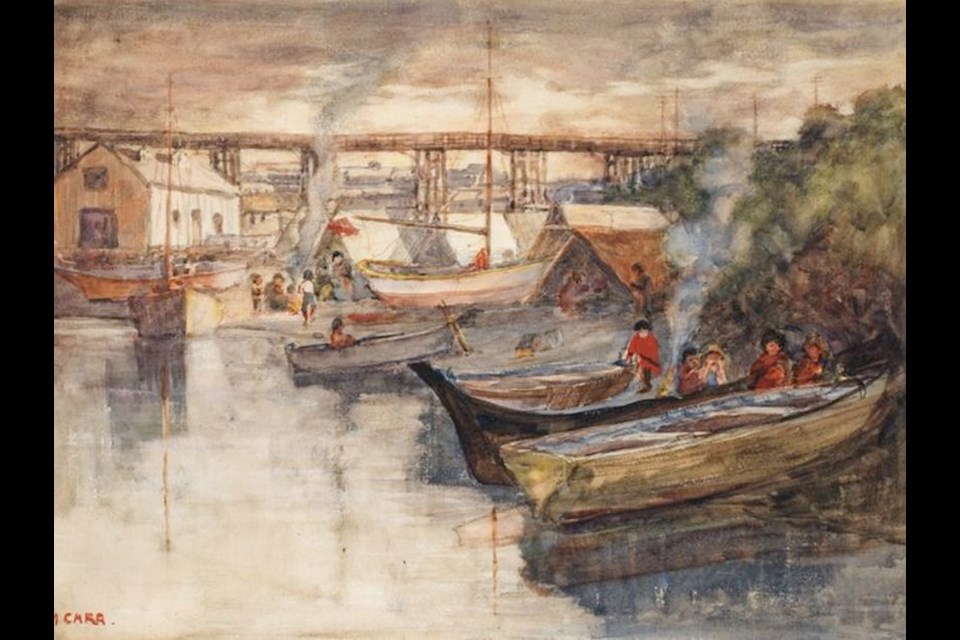The big ticket item at this fall’s Heffel auction of Fine Canadian Art is a Lawren Harris painting of the Rockies that could fetch millions of dollars.
But for Vancouverites, the most interesting painting might be a small watercolour Emily Carr painted in 1908 or 1909.
It’s called Indian Encampment, Vancouver, and offers a rare, perhaps even unique view of the old Kitsilano Indian Reserve on the south side of False Creek.
It depicts a busy First Nations scene on the shoreline just west of the old Kitsilano rail trestle. Several dugout canoes are on the beach, there are a couple of campfires, and First Nations children are playing.
The colours are striking — one person is wearing a deep red blanket, and parts of the water are that lovely grey-blue you sometimes get on a cloudy day.
“It’s quite spectacular,” said Robert Heffel, who runs the Vancouver gallery and auction house with his brother David.
“She had done a boat trip up through Alaska, so she had seen First Nations (up the coast). But this is prior to her 1912 trip (to Haida Gwaii). It shows her early interest in First Nations people and subject matter.”
The painting will be on display from Oct. 28 to 31 at the Heffel Gallery (2247 Granville). It will be auctioned Nov. 22 at the Design Exchange in Toronto, and carries an estimate of $50,000 to $70,000.
Carr was born and died in Victoria, but she lived in Vancouver between 1906 and 1910. After studying painting in Europe, where she was influenced by Fauvism, she returned here in 1912 before moving back to Victoria in 1913.
The Kitsilano Indian Reserve was more or less on the site of today’s Vanier Park, although it stretched as far south as First Avenue, which means it included the approaches to the Burrard Bridge, Molson’s plant and Seaforth Armoury.
It was on the site of a long-standing native village called Snauq.
“Snauq was the basis for a thirty-seven-acre reserve requested in February 1868 by the forty-two persons living there under the leadership of Chief Chip-kay-um and established the next year,” wrote historian Jean Barman in a paper called Erasing Indigenous Identity in Vancouver that was published in B.C. Studies in autumn, 2007.
The reserve was expanded to 80 acres in 1877. After Vancouver was established in 1886, however, the reserve was coveted by various interests. A scandal erupted in 1913 when the provincial government announced it had purchased the reserve off 20 males from the Squamish nation who lived on the site for $225,000.
According to UBC’s Indigenous Foundations website, the federal government wouldn’t let the province take over the site, because the sale didn’t follow the provisions of the Indian Act. But the Squamish who had left didn’t return.
The federal government bought out the provincial government’s interest in the site for $350,000 in 1928. During the Second World War, the site was leased to the Department of National Defence. But the land officially remained a reserve until 1946, when the Squamish council “surrendered” the site.
Images of the Kitsilano Reserve when First Nations were living there are scarce.
“Ever since I wrote that B.C. Studies essay on the Kits reserve, I have looked for such an image, and there it is,” Barman said in an email.
Carr sold or gave the painting to her friend and literary editor Ira Dilworth.
“Ira Dilworth was very, very close to Emily Carr, he would have had the choice of her very best works,” said Heffel.
“And it has remained in the Dilworth family until now.”
The Carr painting isn’t the only historic Vancouver item for sale in the Heffel auction. There is also a beautiful Jack Shadbolt watercolour called Woodward’s Tower from 1946 that features the iconic “Big W” neon sign of Woodward’s department store.
Shadbolt painted Woodward’s from the old Central School Grounds at Pender and Cambie. The former Province newspaper building is in the foreground, and Woodward’s in the back, complete with a billboard that reads “Get It At Woodward’s.” The estimate is $25,000 to $35,000.



